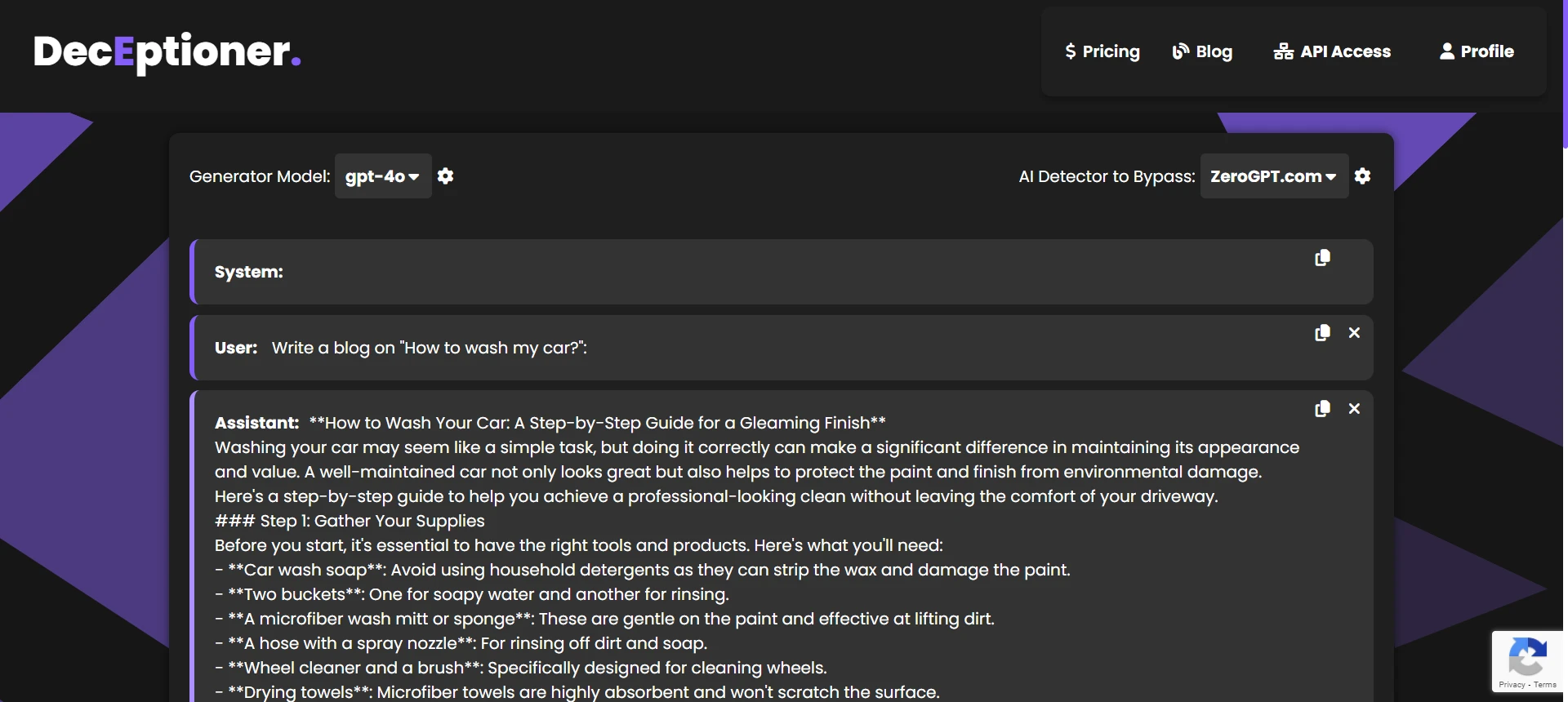Short answer: no, that’s not what it’s built for.
Longer answer: it can nudge you toward more human-sounding writing but only indirectly, and with some big caveats.
In this post, we’ll unpack what GPTZero actually is, what it’s meant to do, its main features, and where this whole “humanizing AI text” confusion comes from.
What GPTZero is actually built for?
GPTZero describes itself as a leading AI detector: a tool that analyzes text and predicts how likely it is to have been written by a large language model like ChatGPT, GPT-5, Gemini, Claude, Llama, and so on.
A few key points about its mission:
- It’s first and foremost a detector, not a writer or paraphraser.
- It’s marketed heavily to educators, students, writers, recruiters, publishers, and businesses as a way to preserve “what’s human” in writing.
- Under the hood, GPTZero started by using perplexity (how predictable the text is) and burstiness (how much that predictability varies from sentence to sentence). Over time it evolved into a multi-layer detection model that considers many more signals. But I would like to tell you that it is still not very different, from say a year ago.
So the design goal is clear: flag AI-generated or AI-assisted text as reliably as possible, not rewrite it to look human.
Also Read: 3 AI Humanizers that Actually Work
GPTZero’s main features (in plain language)
If you land on GPTZero’s homepage, you’ll see that it’s become more than a barebones “paste text, get a score” widget. Here’s the feature set in human terms.
1. Core AI detection tools
- AI Detector / Basic Scan
You paste text or upload a document, hit “Scan”, and GPTZero labels portions of the text as likely human or AI, and gives an overall probability score. - Advanced AI Scan
A more detailed breakdown (usually for paying users) that highlights sections, shows probabilities in more granular form, and focuses on mixed documents (part human, part AI). - AI Vocabulary
Highlights “AI-ish” words and phrases that tend to show up a lot in LLM outputs like repetitive transitions, overused connectors, generic phrases, etc.
2. Writing and quality tools
GPTZero has quietly become a mini writing suite:
- Grammar checker – catches spelling and grammar errors.
- Writing feedback / AI tutor – gives style and clarity suggestions, aimed at helping students and writers improve.
- Citation and fact checker – tries to verify citations and suggest sources for claims.
- Plagiarism checker – scans for copied content from external sources.
- Authorship verification / writing reports – offers “writing video” and typing-pattern reports to help prove that you wrote the text.
3. Classroom and workflow integrations
- Chrome extension – lets you scan any webpage or Google Doc while browsing.
- Google Docs add-on – run scans inside Docs and see feedback as comments.
- Canvas, Moodle, Google Classroom – LMS integrations so teachers can scan student work directly in their existing platforms.
- API & Zapier – plug GPTZero’s detection into custom workflows or apps.
4. Accuracy claims
GPTZero positions itself as one of the most accurate commercial AI detectors, citing things like:
- Internal and independent benchmarks claiming very high accuracy distinguishing AI from human text in some scenarios.
- Strong performance on benchmarks like RAID, where it reportedly detects a high percentage of AI texts while misclassifying only a small fraction of human texts.
That’s the marketing side. Real-world performance, especially on heavily edited or “humanized” AI text, is more complicated (we’ll come back to that).
Also Read: Do AI humanizers Actually Work?
What people mean by “humanize AI text”?
Before we can answer “Can GPTZero humanize AI text?”, we need to be crystal clear about what that phrase usually means.
In practice, “humanizing AI text” can refer to three very different things:
- Legit editing
You use AI as a rough draft generator. Then you rewrite, reorder, fact-check, and inject your own voice and experience. The goal: better content, faster and you’re transparent about using AI if it matters. - Style polish for readability
Fixing robotic tone, over-politeness, and generic phrasing. Making the text sound like you, not like a templated corporate memo. - Detector evasion (the shady one)
Intentionally rewriting AI content so AI detectors don’t flag it. Common in academic cheating, ghostwriting, and low-effort SEO content.
Ethically, (1) and (2) can be totally fine. (3) is where things get murky really fast especially in schools and professional settings.
So when someone asks:
“Can GPTZero humanize AI text?”
They usually mean one of two hidden questions:
- “Will GPTZero help me rewrite AI content so it doesn’t get flagged?”
- “Can GPTZero make my AI text sound more natural and human?”
Those are very different, and GPTZero’s role in each is… limited.
Also Read: Can Perplexity Humanize AI Content?
So… can GPTZero directly humanize AI text?
No. GPTZero does not have a “make this more human” button. It will not help you to bypass any AI detector with the push of a button. You will have to rewrite the parts of text yourself, if it highlights it as AI. If you want a true AI humanizer then you need to go with Deceptioner.
You can:
- Paste your AI-generated text in.
- Let GPTZero highlight the parts it thinks are AI.
- Read its grammar and style feedback.
- Then you manually rewrite, re-order, delete, and add material.
In that sense, GPTZero is more like a diagnostic tool than a fixer: It’s the X-ray, not the surgery.
If your goal is to actually improve the writing make it clearer, more personal, more nuanced you still have to do the work yourself (with or without other tools).
Ways GPTZero can indirectly help your writing sound more human
Even though it’s not an AI humanizer, some of GPTZero’s features can nudge you toward more human-sounding prose — if you’re using it in good faith.
1. AI vocabulary highlighting
AI systems tend to lean on certain “safety” phrases and transitions:
- Overly formal connectors (“Moreover”, “In conclusion”, “Additionally”)
- Repetitive structures (“In today’s world…”, “On the other hand…”)
GPTZero’s AI Vocabulary feature highlights these recurring patterns. That can be a useful signal:
- If a paragraph is lit up from top to bottom, it probably reads a bit too generic.
- You can then swap in more natural transitions, break long sentences, and add specific details.
That doesn’t magically make the text “human,” but it pushes you to actually edit instead of lazily accepting the default AI tone.
2. Writing feedback and grammar check
The writing feedback and grammar checker help you tighten sloppy bits:
- Fix obvious errors (spelling, tense, agreement).
- Smooth clunky sentences.
- Make paragraphs flow better.
Again: this is standard writing-assistant behavior. It’s useful whether the text started as human or AI. What matters is that you are making intentional decisions, not just pushing a “bypass detector” button.
3. Authorship reports pushing you to write more yourself
For students and professionals, features like authorship verification and typing-pattern video can be a subtle reminder:
“If I don’t actually write this myself, this tool might notice.”
That can push people away from total copy-paste jobs and toward hybrid workflows: brainstorming with AI but drafting and editing more manually.
None of this is the same as “GPTZero humanizes your AI text,” but it does incentivize more genuine writing.
Also Read: Can Grammarly Humanize AI Text?
Where GPTZero falls short (especially with “humanized” AI)?
Here’s where things get interesting.
A recent study from the University of Chicago tested several detection tools (including GPTZero) against both raw AI text and text run through AI humanizers. GPTZero performed decently overall, but struggled with humanized AI content, missing around half of those cases (roughly a 50% false-negative rate in that specific scenario).
What that means in practice:
- If text has been heavily rewritten or paraphrased, GPTZero may not reliably flag it as AI.
- At the same time, like all detectors, it can sometimes false-flag genuine human writing, especially if your style happens to look “too clean” or “too uniform.”
So GPTZero is stuck in a tricky middle ground:
- It’s good enough that institutions are tempted to trust it.
- It’s imperfect enough that over-reliance can hurt innocent writers and still won’t catch every disguised AI passage.
This is why many researchers and educators warn against using AI detectors as the sole basis for serious decisions like failing a student, firing an employee, or accusing someone of plagiarism.
Ethical reality check: detectors vs. “beating the system”
If your goal is:
- “I want my writing to sound more like me.”
- “I’m co-writing with AI but still want my authentic voice.”
Then using GPTZero + honest editing can be part of a healthy workflow.
If your goal is:
- “I want to dump AI text into a humanizer so teachers, clients, or employers never know I didn’t write it,”
you’re no longer in “writing improvement” territory — you’re in deception.
Tools like GPTZero weren’t built to help you cheat detectors; they were built to make AI usage more transparent and responsible, especially in high-stakes environments like education and hiring.
Relying purely on “can detectors catch me?” is a risky game:
- Detectors can miss things.
- Detectors can misfire on honest work.
- Policies are evolving quickly, and getting caught with obviously AI-authored work (even if a detector didn’t flag it) can still have consequences.
FAQs
Q1. Is GPTZero an AI humanizer?
No. GPTZero is explicitly positioned as an AI content detector, not a humanizer, paraphraser, or undetectable rewriter. Its job is to estimate whether text is AI-generated, not to disguise AI output.
Q2. Can GPTZero rewrite AI text for me?
Not directly.
You can:
- Use GPTZero to scan your text.
- See which parts look “AI-ish” according to its model.
- Then manually rewrite, expand, or delete those pieces using your own judgment.
Any “humanizing” happens because you edit better, not because GPTZero rewrites it behind the scenes.
Q3. Does GPTZero reliably detect humanized AI content?
Not always.
That University of Chicago–linked study found that GPTZero struggled with AI text that had been run through humanizer tools, with about half of such samples slipping through as “non-AI.”
That doesn’t mean detectors are useless, just that they’re not magic lie detectors, especially when the text is short, heavily paraphrased, or mixed.
Q4. Is GPTZero safe to use for high-stakes decisions?
It’s safer to treat GPTZero as one signal among many, not a final judge:
- In classrooms, it can flag suspicious cases for further conversation, not automatic punishment.
- In publishing or hiring, it can prompt a closer review of suspicious pieces, rather than instant rejection.
Even GPTZero itself acknowledges that no detector is 100% perfect, and that it should be part of a broader, responsible AI policy.
Q5. When should you use GPTZero?
Good use cases:
- Teachers checking how much AI might be in a batch of essays.
- Students double-checking that their own writing isn’t being misread as AI before submission.
- Editors and publishers scanning submissions when originality matters.
- Recruiters screening suspiciously similar cover letters or test assignments.
In all of those, the goal isn’t “beat the system,” but understand what role AI played and make better decisions from there.
The Bottom Line
So, back to the original question:
Can GPTZero humanize AI text?
- No, in the sense of a one-click “make this human” switch. GPTZero is not built to rewrite or disguise AI output.
- Yes, very indirectly, in the sense that:
- It highlights AI-like patterns.
- It gives you grammar and style feedback.
- It nudges you to put more of your brain and voice into the draft.
But if your plan is to use GPTZero as a stealth humanizer to slip AI-written work past people who expect genuine human effort, you’re using it against the grain of what it was designed for and skating on thin ethical ice.
If you want “human-sounding” writing, the most robust play is still boring and old-fashioned:
- Use AI as a brainstorming buddy or rough-draft engine.
- Rewrite ruthlessly in your own words.
- Add lived experience, specific details, and actual opinions.
- Be honest about when and how you used AI if the context requires it.
GPTZero can help you see where the text still smells like a machine. Only you can make it truly human.

![[G0] Can GPTZero Humanize AI Text?](/static/images/can-gptzero-humanize-ai-textpng.webp)
![[HOT TAKE] Why is ZeroGPT so bad?](/static/images/why-is-zerogpt-so-badpng.webp)
![[DIRECT] Best Affordable AI Humanizers (That Still Work in 2025)](/static/images/best-affordable-ai-humanizerspng.webp)
![[HOT] Can You Compare ZeroGPT With Other Top Tools?](/static/images/can-you-compare-zerogpt-with-other-top-toolspng.webp)





